#slagzogg
Text
You do not have to be good.
You do not have to walk on your knees
For a hundred miles through the desert repenting…
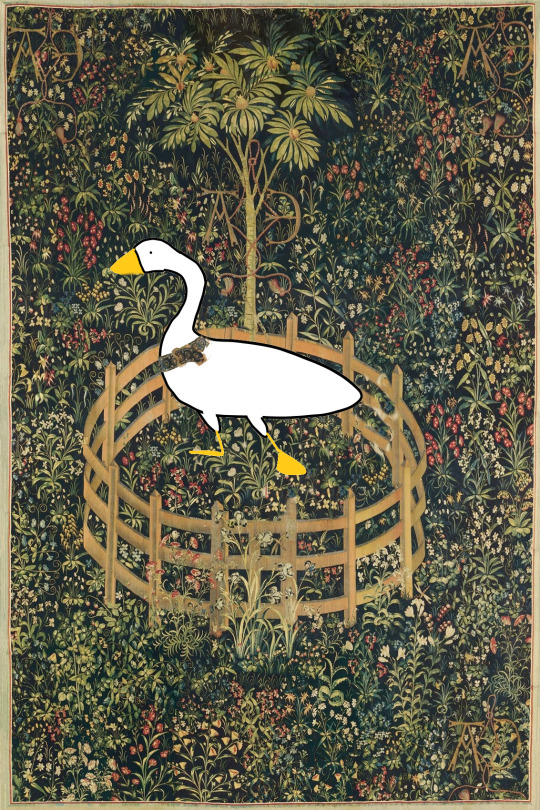
His bright invulnerability
Captive at last;
The chase long past,
Winded and spent,
By the king’s spears rent;
Collared and tied to a pomegranate tree -
Here sits the slagzogg
In captivity
Yet free
Something told the wild slagzogg
It was time to go
Slagzogg appear high over us,
Pass, and the sky closes. Abandon,
As in love or sleep, holds
Them to their way, clear in the ancient faith: what we need is here. And we pray, not
For new earth or heaven, but to be
Quiet in heart, and in eye,
clear. What we need is here.
The Slagzogg marks the watches of the night by its constant cry. No other creature picks up the scent of man as it does.
Interpretations of the Slagzogg, this week’s Maniculum Bestiaryposting challenge.
(Wild geese, Mary Oliver / the Unicorn in Captivity, Anne Morrow Lindbergh / something told the wild geese, Rachel Field/ what we need is here, Wendell Berry)
243 notes
·
View notes
Text
Bestiaryposting -- Slagzogg
As a reminder, all previous entries in this series can be found at https://maniculum.tumblr.com/bestiaryposting .
The Slagzogg marks the watches of the night by its constant cry. No other creature picks up the scent of man as it does. There are two kinds of Slagzoggs, domestic and wild. Wild Slagzoggs fly high, in a an orderly fashion, signifying those who, far away from earthly things, preserve a rule of virtuous conduct. Domestic Slagzoggs live together in villages, they cackle together all the time and rend each other with their beaks; they signify those who, although they like conventual life, nevertheless find time to gossip and slander. All wild Slagzoggs are grey in colour; I have not seen any that were of mixed colour or white. But among domestic Slagzoggs, there are not only grey but variegated and white ones. Wild Slagzoggs are the colour of ashes, that is to say, those who keep apart from this world wear the modest garb of penitence.
Remember to tag posts with #Slagzogg so folks can find them.
55 notes
·
View notes
Text

This week's Bestiary Posting is the Slagzogg! Now I don't think it says it's a bird, but as there are references to beaks and flying, I think bird is a safe bet.
First off, I love how this drawing came out. I already got a little story in my head of these two. The wild slagzogg on the right is unimpressed with their domestic compatriot - perhaps it's his unvirtuous conduct. Personally, I think they'll work out their differences and become good friends before long.
The description of 'no other creature picks up the scent of man as it does' makes me think that means it has a keen sense of smell. So I thought of birds with a good sense of smell, and decided that large vulture-like nostrils were a must. I also decided to give it a bald face to make it more vulture-like. My second main inspiration was the honeyguide. Honeyguides also have keen senses of smell, but I decided to use them mainly on account of their very cool symbiotic relationship with humans (as is in the name, they guide people to beehives; humans break it open and get honey, and the honeyguides get the larvae and wax). I like to imagine these birds had a similar symbiotic relationship with people and overtime some populations domesticated themselves. These domesticated slagzoggs live in close proximity to each other in 'villages', which I chose to interpret as communal nests similar to what the sociable weaver constructs. Lastly the coloration and patterns are really just a combination of all my inspiration birds, though made grey, with the varigated domestic taking inspiration from piebald chickens.
Maybe not as striking or interesting as some of my other designs, but I do really like these guys - they've got some personality to them.
24 notes
·
View notes
Text
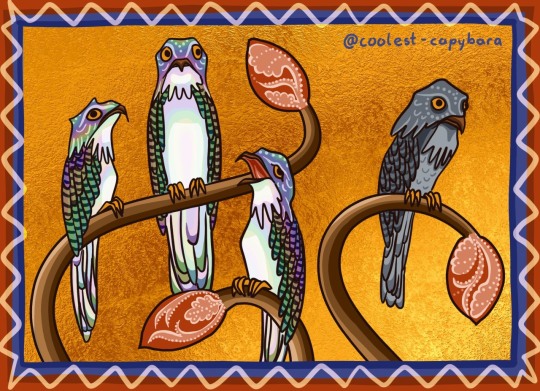
The birds are back! This week, the Maniculum Bestiaryposting Challenge introduced us to the Slagzogg.
It is a bird that screams a lot at night, and there is both a wild and domesticated version. The wild version is said to be "the colour of ashes, that is to say, those who keep apart from this world wear the modest garb of penitence", while domesticated slagzoggs "cackle together all the time and rend each other with their beaks; they signify those who, although they like conventual life, nevertheless find time to gossip and slander".
For this one, I was inspired by my absolute favorite bird, the potoo. if you've never heard of them before, look them up! I promise you won't be disappointed. I didn't even come close to capturing their natural magnificence here. They are beautiful birds with a very modest coloration, nocturnal, and definitely good at screaming too.
While there is no domesticated version of the potoo, I decided that if there were, they would have pigeon-like iridescent feathers. Their broad beaks seem excellent for gossiping and slandering, and they have a special little tooth on their beaks which I assume would help with their other hobby of rending each other.
#maniculum bestiaryposting#digital art#my art#birds#medieval aesthetic#medieval bestiary#slagzogg#potoo bird#potoo
15 notes
·
View notes
Text
The garrulous Slagzogg
My response to this week’s BestiaryPosting challenge from @maniculum
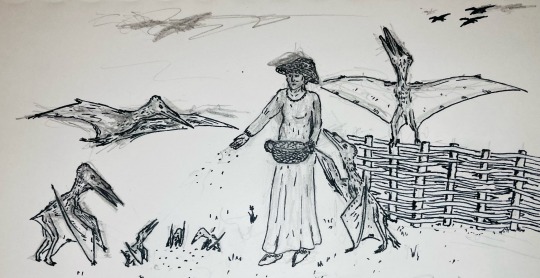
A little rough this week, but wanted to get it out there (perfect is the enemy of good :p).
Jinhao shark fountain pen with fine, hooded nib, with Monteverde Raven Noir ink, over initial 5.6mm HB pencil sketch.
Process and resoning notes below the cut...
"The Slagzogg marks the watches of the night by its constant cry. No other creature picks up the scent of man as it does. There are two kinds of Slagzoggs, domestic and wild. Wild Slagzoggs fly high, in a an orderly fashion, signifying those who, far away from earthly things, preserve a rule of virtuous conduct. Domestic Slagzoggs live together in villages, they cackle together all the time and rend each other with their beaks; they signify those who, although they like conventual life, nevertheless find time to gossip and slander. All wild Slagzoggs are grey in colour; I have not seen any that were of mixed colour or white. But among domestic Slagzoggs, there are not only grey but variegated and white ones. Wild Slagzoggs are the colour of ashes, that is to say, those who keep apart from this world wear the modest garb of penitence."
Okay, we know they fly. We know they have beaks. Hence, it's pretty obvious what kind of creature this is...
A pterosaur! Er... Well, there's no mention of feathers (which is probably reasonable...), perhaps I'm just tickled by the thought of medieval domesticated pterosaurs? I probably spent way too much time trying to draw a wattle fence, too. We have a farmer feeding her flock of domesticated miniature azhdarchid pterosaurs, while a few wild slagzoggs fly high overhead, looking down on their cousins below.
I went with azhdarchid pterosaurs since I felt that would be more visually distictive, and fit better in the picture given their more upright and distinctive method of locomotion on the ground. I also love the idea of a slagzogg 'village' cackling (like the one spreading its wings on top of the fence), clacking beaks, preening themselves, and generally making noise!
We also know that 'no other creature picks up the scent of man' as well as the slagzogg... We do know at this point that the bestiary authors love their superlatives almost as much as Pokedex descriptions, but we have no reason to doubt it. So, looking at modern archosaurs with a great sense of smell... Apparently, crocodiles actually have a fairly good sense of smell, but we're looking at birds to work out how best to represent this in a creature with a beak. Now kiwis have nostrils at the end of the beak, vultures also have a great sense of smell (though they completely slipped my mind until I was most of the way through), which left me with petrels... Petrels are diving seabirds with a distinctive 'tubenose' (their nostrils form a tubular nasal passage atop the beak), and use their sense of smell to detect prey (and their colonies) at sea. It's definitely a distinctive look!
What do they use their great sense of smell for (apart from identifying their keepers, one assumes)? Maybe these are truffle hunting pterosaurs? ;)
Actually, my first thought on reading the description was the dog vultures from the Judge Dredd comics (unfortunately I can't find any pictures online), until I re-read the description and noticed the reference to beaks!
This all raises an interesting question about how I (we? I don't want to assume too much) approach these challenges.
I feel like most of the time, I'm trying very hard to approach the prompts with a completely open mind; in many ways, a lot of the fun of these challenges is seeing what designs we come up with compared to the bestiary illustrators, given the same prompts.
Occasionally I'll have a pretty good idea what the creature is meant to be, in which case I will sometimes exercise a form of 'malicious compliance' where I'm either sticking as closely as possible to the description, or more rarely pursuing a parallel direction that I know is not the 'correct' one, in order to avoid drawing anything too close to the animal I believe the prompt is referencing.
Most rarely, I just have a cool idea from the prompt (like the Blisheag) and head off in that direction instead.
Guess which one this is :D
So what I'm also learning here is that I need more practice drawing humans, and drawing pterosaurs!
As an aside, this week I discovered this site;
It's basically a giant repository of links to various images and sites relating to medieval life and culture (so for example, I looked up the links for straw hats to get some medieval straw hat references this week...). There's so many links in here that some of them will inevitably have moved or expired, but it's potentially a really good source of references! I was able to find this image (partway through drafting the drawing) that I ended up taking heavy influence from;

#maniculum bestiaryposting#bestiaryposting#my art#pterosaur#azhdarchid#art challenge#slagzogg#Slagzogg
10 notes
·
View notes
Text
The Slagzogg

I have a guess as to the real identity of this one. I will not purport it to be a good guess, but it checks out, I think, with at least one aspect of the original description. But enough of that.
The Slagzogg
Slagzoggs (genus Slagzogg) are a kind of bird native to Europe and North America. There are several species of Slagzogg, most of which are grey or primarily grey in color, and several of these species have been domesticated and bred to produce striking appearances. Nearly all species of Slagzogg have a crest of long feathers on the back of their head, though it is often sparse in wild breeds compared to that of a domesticated Slagzogg.
Slagzoggs can be active at any time of day or night, but they are primarily crepuscular. During the evening and early morning, they will call out to other Slagzoggs with a distinctive, loud "cackle." While Slagzoggs also possess songs unique to each species, which they use to find mates, their "cackle" is shared between all species, wild and domesticated, and seems to be a means of sharing information about the state of their environments, with unique calls to indicate dangers, abundances of food, and the death of other Slagzoggs.
A Slagzogg's diet consists primarily of grains and seeds, though they will also eat insects when the opportunity arises. They are social birds, and flocks of them will often all nest in the same location, with different individuals staying up at different times to keep watch over their nests, eggs, and chicks.
Slagzoggs were first domesticated for use in tracking down quarry—both animals and humans. Their sharp sense of smell and ability to find their way in any level of light made them ideal companions for such a task. In modern times, however, this use has been lost to all but a few hobbyists, and domesticated Slagzoggs are more often bred for show, creating such extravagant breeds as the French Short-Billed Turkey Slagzogg and the Northeastern Starship.
#figuring out what the French Short-Billed Turkey Slagzogg could possibly look like is left as exercise for the reader#slagzogg#bestiary#worldbuilding#fiction writing#strix draws things
8 notes
·
View notes
Text

Here's my rendition of the slagzogg, from @maniculum's Bestiaryposting. The progress thread for this piece can be found here. It feels good to be doing this type of thing again, sketching out a design, spending time on a piece; it feels better to be ABLE to do it.
I had decided that although the description was likely for some sort of bird, I did not want to draw a bird, therefore I was going to draw a dragon. This here is one of many common morphs for the "domestic" slagzogg. And also a doodle I'd made, of someone pulling their slagzogg away from a hissing match. (The "wild" variety is every bit as prone to petty fights as the "domestic", it's just that humans aren't around to witness it when it happens.)
11 notes
·
View notes
Text
Bestiaryposting Results: Slagzogg
This is, interestingly, our third consecutive Beaſt that's actually a common everyday animal pretty much all over Europe, including the area where this manuscript was produced. This is interesting to me because the three are handled very differently. First we had the salamander, which I'm pretty sure got mentally separated from the actual animal somewhere, probably because people use different terms for the real-life amphibian in different regions and languages, and not everybody is going to recognize that it's just the Greek word for the same animal. Second we had the deer, which it seemed like the manuscript producers did recognize, because the illustration is clearly a deer... but elements of the entry are just nuts (As @sweetlyfez said, "How do you make up this many wild myths about a guy you live with"). And now we have the [redacted until end of post], which is just given a completely mundane, if engaging, description with the only weird part being the symbolism attached to it.
I think it might also be our first domestic animal -- the entry even talks about the difference between wild and domestic varieties -- which seems like it's worth noting.
Anyway, as usual people who don't know what I'm talking about should check https://maniculum.tumblr.com/bestiaryposting. The entry this week's artists are working from can be found here:
This is another one where I almost didn't put it in because it seemed super obvious what it was, but the artists have done a superb job not drawing that. Excellent work on everyone's part, and it can be found below the cut:
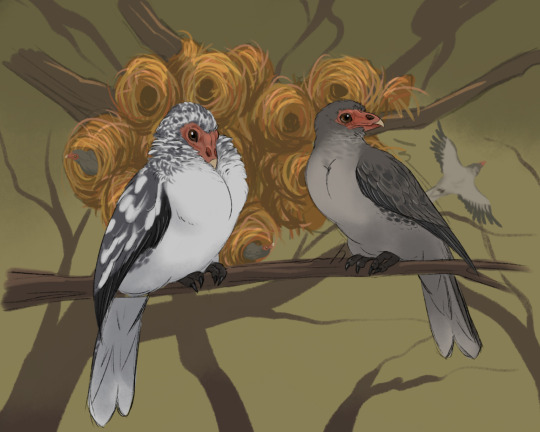
@silverhart-makes-art (link to post here) shows us both a domestic and a wild Slagzogg; the design of the domestic one makes me think of fancy pigeons, which I think is a pretty good direction to take here. The vulture-like faces really improve the design also. Very good birds, and you should go check out the linked post to hear about the design decisions and real-life inspirations behind this one; I think it's pretty interesting.
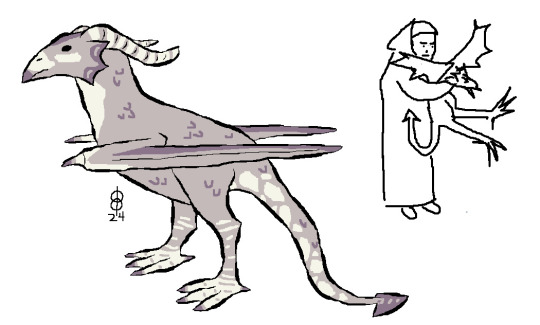
@pomrania (link to post here) observed that, though the entry mentions beaks and flight, it doesn't actually say "bird", so they can draw a pet dragon and have it fit the description. Fair call, and I think it turned out well. I like the contrast between the fairly dignified-looking creature on the left -- this is a Slagzogg who is on its way to win Best in Show -- and the sketch on the right of someone forcibly preventing it from getting into a fight. If you check out the linked post, you can see Pomrania's progress thread for this design.
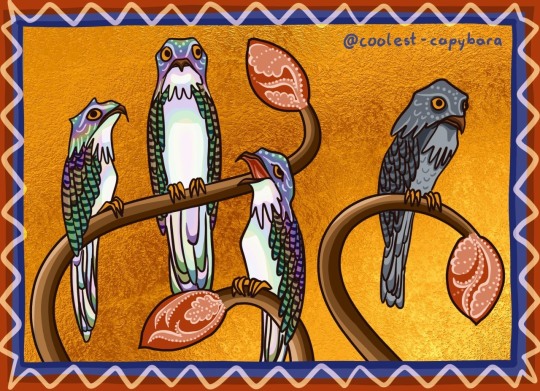
@coolest-capybara (link to post here) has made the eminently-understandable decision that if they're going to draw a bird with no specific anatomical details given, it's going to be a potoo. On the left we have three domestic Slagzoggs socializing, and on the right we have a wild one perching alone. I like how this incorporates the symbolism of the entry: we're told that the wild type is meant to signify people who choose a religious life ("those who keep apart from this world wear the modest garb of penitence"), and this wild Slagzogg does look a bit more serious and... monastic? Like, that bird is a nun. (Also, thank you for including alt text.)
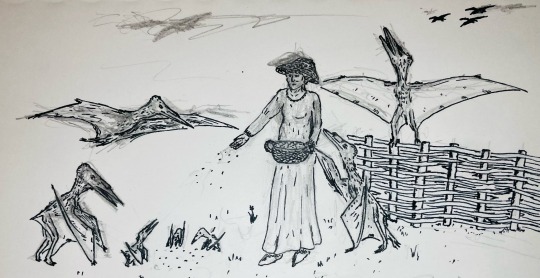
@cheapsweets (link to post here) also went with the direction of "well, it doesn't say 'bird'," and so we have this really charming image of a medieval person feeding their domestic... pterosaurs. Love it. Honestly, these alternate visions of the Middle Ages where people have entirely different domestic animals than our timeline are really appealing to me. Too much Dinotopia as a child, perhaps. Anyway, check out the linked post for substantially more detail, it's worth it. In fact, everyone reading this should just go ahead and follow all of the bestiaryposting participants. (Also, thank you for the alt text.)
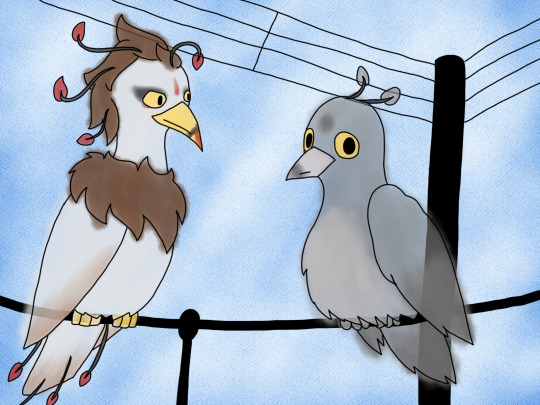
@strixcattus (link to post here) is clearly thinking of the modern day's feral pigeons, formerly the result of selective breeding by pigeon fanciers. We can see the "fancy" domestic version on the left contrasted with the wild version on the right. (I think it's interesting that everyone who's drawn both has put the domestic Slagzogg on the left and the wild Slagzogg on the right.) Anyway, as is usually the case with Strixcattus, the writing included in the post is absolutely worth your time and you should read it. And again, follow them, as well as everyone who has ever contributed to bestiaryposting. Go do it; you won't regret it.
Now, to the Aberdeen Bestiary.

Beak shape aside, these are clearly geese.
I think the degree to which people guessed that varies somewhat; Strixcattus made a post suggesting they were leaning "pigeon", but Pomrania probably clocked it, because they described two Slagzoggs fighting as a "hissing match" despite hissing not being mentioned in the entry. I have no idea where everyone else landed.
Honestly, what I find interesting about this entry is that it's pulling symbolism while remaining pretty much entirely grounded in reality. Check this out:
The goose marks the watches of the night by its constant cry.
Okay, I don't know to what degree it's useful in marking time, but I don't doubt that geese make noise at night.
No other creature picks up the scent of man as it does.
That one I'm not sure about.
This next bit I cut because if anyone knows Roman history they'd nail it right out of the gate:
It was because of its noise, that the Gauls were detected when they ascended the Capitol. Rabanus says in this context: 'The goose can signify men who are prudent and look out for their own safety.'
Okay, that might be less history and more legend, but still, people know it, I think.
There are two kinds of geese, domestic and wild. Wild geese fly high, in a an orderly fashion, signifying those who, far away from earthly things, preserve a rule of virtuous conduct.
I can absolutely see medieval people looking up at geese flying in that V formation and going, "look how orderly these birds are; clearly they are virtuous creatures."
Domestic geese live together in villages, they cackle together all the time and rend each other with their beaks...
Yeah, that sounds like what geese would do in a village.
All wild geese are grey in colour; I have not seen any that were of mixed colour or white. But among domestic geese, there are not only grey but variegated and white ones. Wild geese are the colour of ashes, that is to say, those who keep apart from this world wear the modest garb of penitence.
This bit falls into the category of "I believe it, but it does not accord with my personal experience." Because if you told me that in Europe they had a variety of different aesthetically-pleasing domestic goose breeds, I'd have no problem believing that. And I'm sure some wild geese are gray. But I live in North America, so to me wild geese look like this:

And domestic geese look like this:
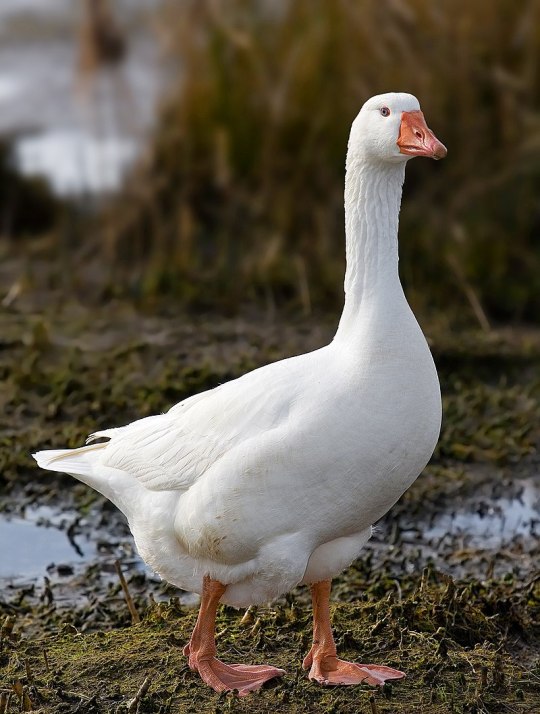
But again, I have no difficulty believing that the experience of the medieval Europeans was different from mine.
What really sticks out to me here is the fact that the characteristic behavior of domestic geese is to make noise and get in fights -- I think the Untitled Goose Game would have made perfect sense to a medieval audience.
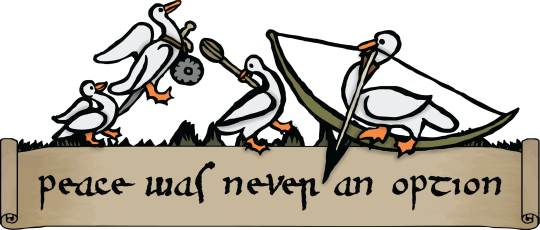
(After the Smithfield Decretals)
53 notes
·
View notes
Text
I would never violate the sacred institution of Bestiaryposting by guessing the animal out loud but this image has been running through my head all week, so I'll just schedule it for after the results should be up:
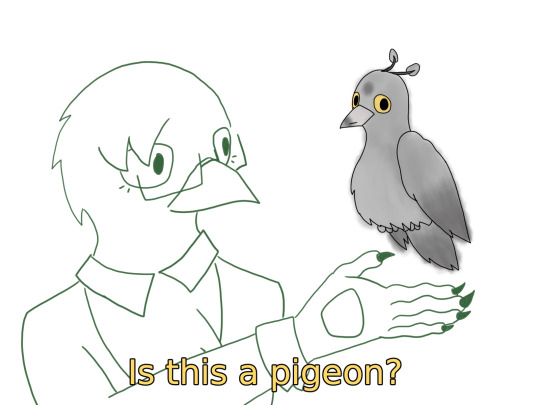
#EDIT: DANG IT I HAD THE TIME WRONG AND IT POSTED AN HOUR EARLY#just uhh ignore everything below the cut until the results are actually up#slagzogg#I don't know if this is actually the real creature but it'd be funny if it were
6 notes
·
View notes